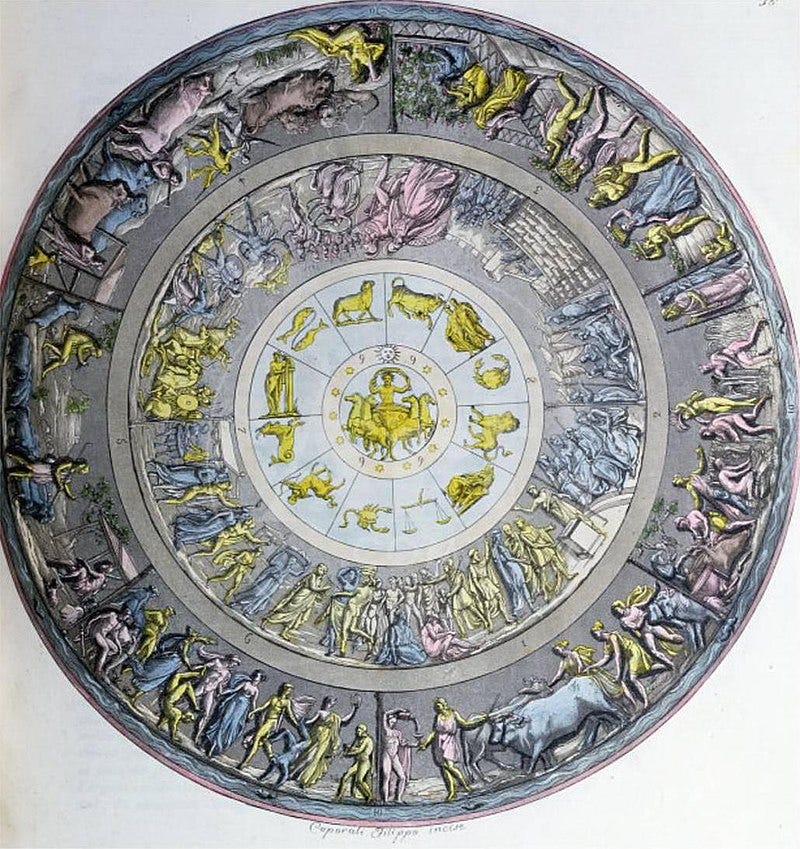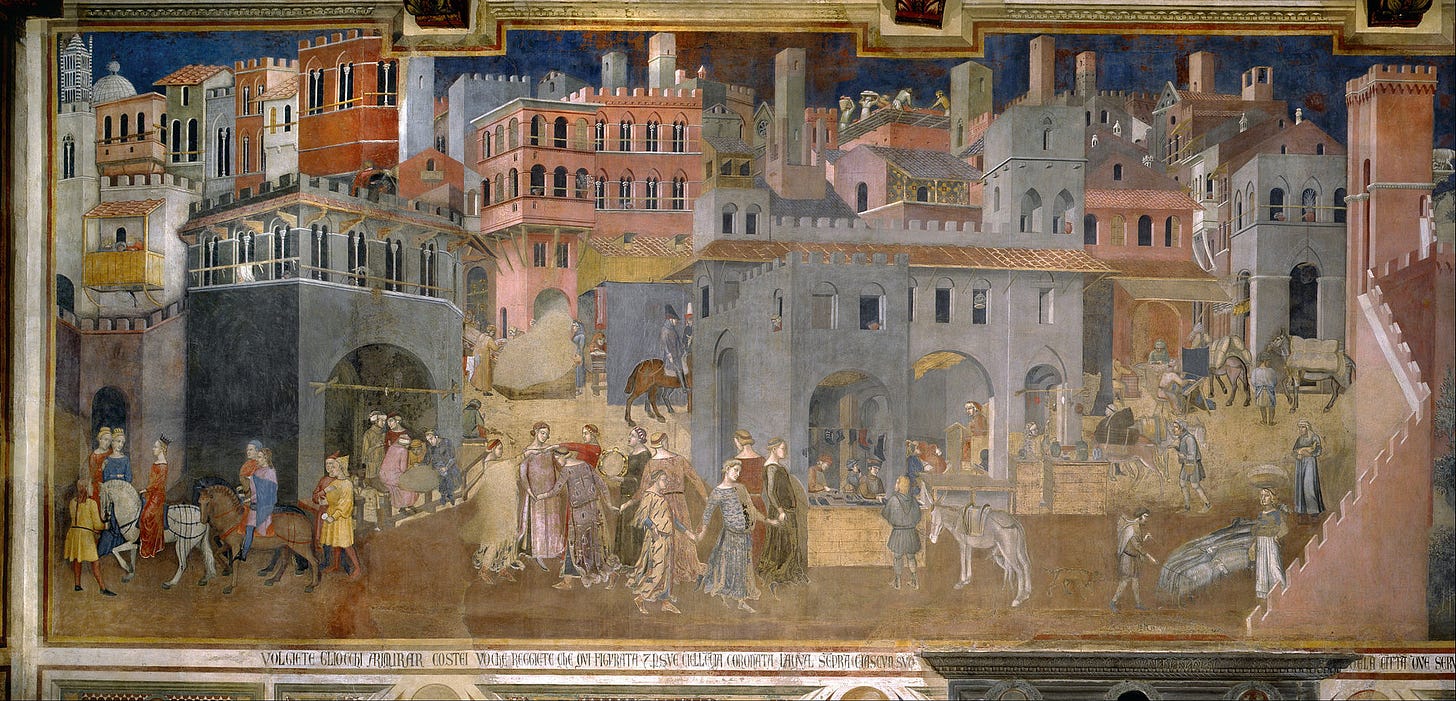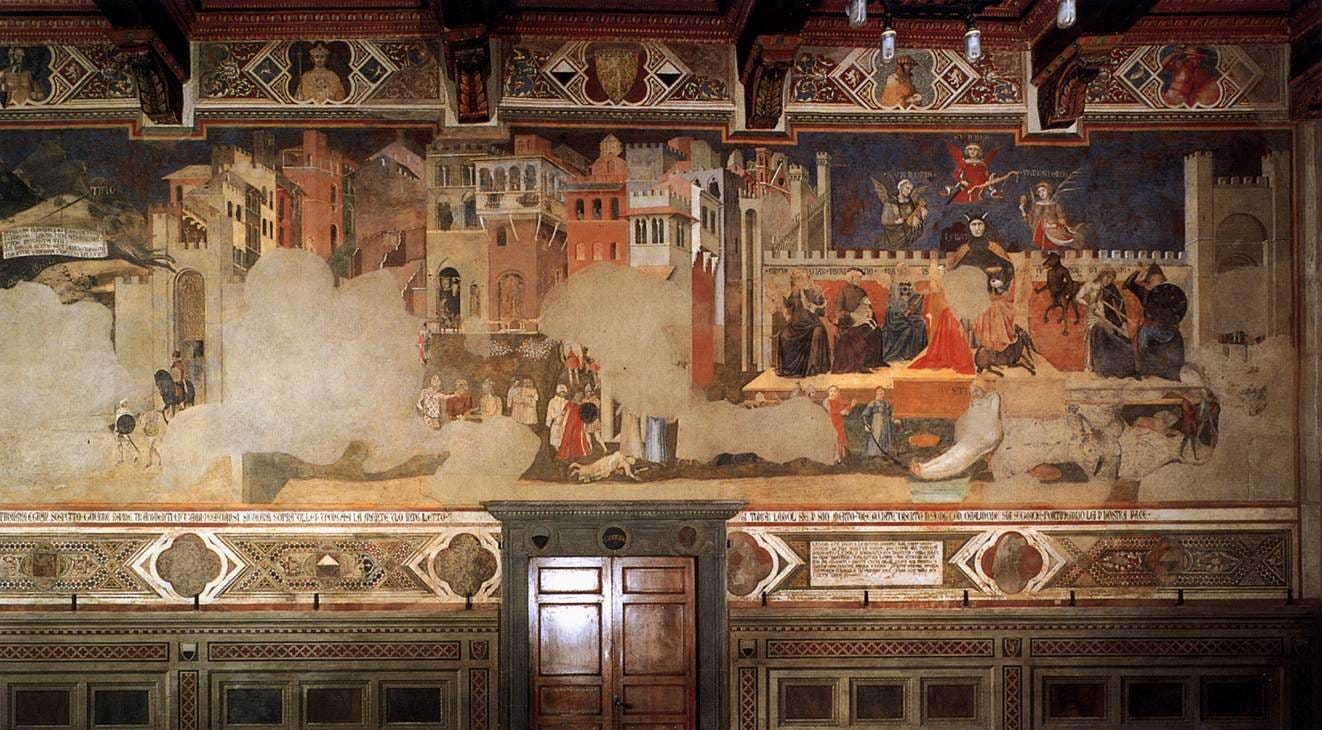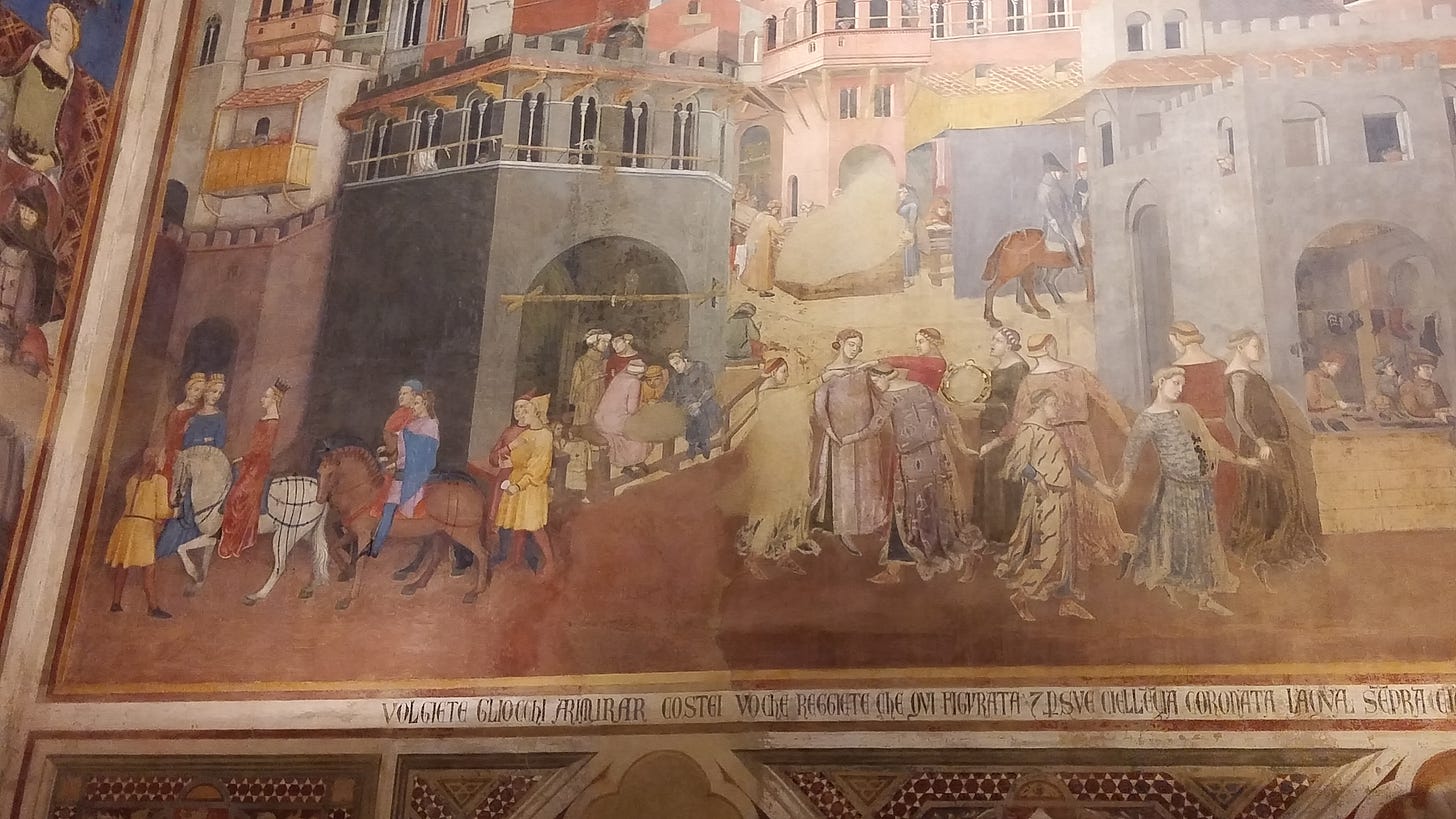This is one of a few posts dedicated to Iliad 18. As a reminder, these posts will remain free, but there is an option to be a financial supporter. All proceeds from the substack are donated to classics adjacent non-profits on a monthly basis.
In literary studies Ekphrasis has acquired a specialized meaning as a description of a work of art within a verbal or textual creation. Ekphrasis has been singled out for the perspective it offers on a text’s consciousness of its status as a literary object and for the reflections it offers on the poetics of the work in question. This means that we imagine that there is some kind of correlation between the creative acts depicted within the poem and the logic/aesthetics of the poems themselves.
Epic ekphrasis occurs elsewhere (e.g. the description of Agamemnon’s scepter, Il. 1.234-9 and 2.100-9) or longer, (e.g. the shield in the Hesiodic Aspis). Described objects may impact the characterization of human actors. For example, Agamemnon’s scepter marks the magnitude of Achilles’ alienation (1.234-9) or emphasizes Agamemnon’s association with traditional kingship (2.100-9).

Achilles’ shield in the Iliad (18.462-613) encompasses the entire cosmos and defies accurate visualization. While we see characters responding to the shield, there’s no clear indication of what it means to them. (Although Robert Rabel has suggested that Hektor “reads” the shield and its scenes shape his speeches in book 22). Like similes, an ekphrasis compares the world inside the poem to potential worlds outside it. In book 18, Achilles’ shield contrasts the Iliad with other possible realities: a city at peace and a conflict resolved without violence (discussed below).
But one of the most fascinating scenes, for me, happens within the city of peace. Here, Hephaestus creates the image of an assembly where a killing is being judged:
Homer, Il. 18.496-508
“The people where gathered, crowded, in the assembly where a conflict (neîkos)
had arisen: two men were striving over the penalty for
a man who had been killed; the first one was promising to give everything
as he was testifying to the people; but the other was refusing to take anything;
and both men longed for a judge to make a decision.
The people, partisans on either side, applauded.
Then the heralds brought the host together; the elders
sat on smooth stones in a sacred circle
as they held in their hands the scepters of clear-voiced heralds;
each one was leaping to his feet and they pronounced judgments in turn.
In the middle there were two talents of gold to give
to whoever among them uttered the straightest judgment.”λαοὶ δ’ εἰν ἀγορῇ ἔσαν ἀθρόοι• ἔνθα δὲ νεῖκος
ὠρώρει, δύο δ’ ἄνδρες ἐνείκεον εἵνεκα ποινῆς
ἀνδρὸς ἀποφθιμένου• ὃ μὲν εὔχετο πάντ’ ἀποδοῦναι
δήμῳ πιφαύσκων, ὃ δ’ ἀναίνετο μηδὲν ἑλέσθαι•
ἄμφω δ’ ἱέσθην ἐπὶ ἴστορι πεῖραρ ἑλέσθαι.
λαοὶ δ’ ἀμφοτέροισιν ἐπήπυον ἀμφὶς ἀρωγοί•
κήρυκες δ’ ἄρα λαὸν ἐρήτυον• οἳ δὲ γέροντες
εἵατ’ ἐπὶ ξεστοῖσι λίθοις ἱερῷ ἐνὶ κύκλῳ,
σκῆπτρα δὲ κηρύκων ἐν χέρσ’ ἔχον ἠεροφώνων•
τοῖσιν ἔπειτ’ ἤϊσσον, ἀμοιβηδὶς δὲ δίκαζον.
κεῖτο δ’ ἄρ’ ἐν μέσσοισι δύω χρυσοῖο τάλαντα,
τῷ δόμεν ὃς μετὰ τοῖσι δίκην ἰθύντατα εἴποι.
When we write about this scene in Homer’s Thebes, Elton Barker and I emphasize the following:
Equally clearly, however, the scene on the shield depicts an institutional framework far more developed than anything represented in the story-world of the Iliad. Two plaintiffs testify to the people (demos) in the assembly (agora); the people (laos) support either side; an arbitrator (histor) adjudicates; elders pass judgment; prizes are “in the middle,” ready to be given to the elder who passes the “straightest judgment.” Given this picture of a community working together to resolve strife without a role for named individuals (far less for heroes), this seems to be a far cry from Homer’s world of warring heroes. In fact, the emphasis on communal performance, to the erasure of individual identities, amounts to something of an anti-heroic-epic aesthetic.
I think this probably needs a little more unpacking, though. When I read this now—in line with the themes I have been exploring book-by-book—I think there are two aspects of this scene to be explored: (1), intra-textual resonance; and (2) metapoetic reflection. The first aspect engages with the epic’s political concerns; the second reflects its interest in storytelling.
One of the important questions from the beginning of the epic is how to adjudicate and resolve conflict without violence. This is directly related to the conflict between Achilles and Agamemnon in book 1, but it also invites consideration of the entire Trojan War. Indeed, one of the themes that unites both the Iliad and the Odyssey is the danger of cycles of vengeance and punishment. The shield imagines a world where actual violence has been done and a community resolves it without further bloodshed. Yet, even in Homer’s world, we hear from characters that there are other options when a conflict arises. During the embassy to Achilles, Ajax complains:
Homer, Iliad 9.632-638:
“You are relentless: someone might even accept payment
for the murder of a brother or the death of his own child.
and after making great restitution, the killer remains in his country,
and though bereft, the other restrains his heart and mighty anger
once he has accepted the price. But the gods put an untouchable
and wicked rage in your heart over only a girl…”νηλής• καὶ μέν τίς τε κασιγνήτοιο φονῆος
ποινὴν ἢ οὗ παιδὸς ἐδέξατο τεθνηῶτος•
καί ῥ’ ὃ μὲν ἐν δήμῳ μένει αὐτοῦ πόλλ’ ἀποτίσας,
τοῦ δέ τ’ ἐρητύεται κραδίη καὶ θυμὸς ἀγήνωρ
ποινὴν δεξαμένῳ• σοὶ δ’ ἄληκτόν τε κακόν τε
θυμὸν ἐνὶ στήθεσσι θεοὶ θέσαν εἵνεκα κούρης
οἴης• …
The resonance in this passage with the larger framework of myth and the war is clear (“over only a girl....”), but the language Ajax uses is suffused with concerns about Honor, payback, and vengeance. The scene within the shield is a companion piece to this moment and it completes it by inviting the audience to imagine the situation Ajax describes, where someone provides restitution for a harm done and thereby keeps a community whole. In the shield, there is a conflict over the restitution (...εἵνεκα ποινῆς) using the same noun Ajax emphasizes (ποινὴν).
The second aspect of this scene—the metapoetic one—is clearer if we specify what is missing in the embassy speech. Ajax frames an idea—that one offers and accepts restitution—but he does not imagine a process or institution to make it happen. The shield creates an institution and centers the prize in gold for those who are making the judgments, who are evaluating the claims. When Ajax speaks in book 9, the audiences are the judges about the rightness of what he says.
I use plural audiences here to indicate that Ajax is speaking to an internal audience (Achilles, the other members of the assembly) as well as to an external audience (us!). We don’t know if any audiences internal to the poem see and reflect on this scene of dispute on the shield; but we do know when we, the external audience, makes the connection. The highest value the Iliad places in this intratextual move is on the ability to interpret the story and render some judgment about what is right or wrong in it. Achilles had the chance, and it seems pretty much like he failed.
In a way, this move is like that scene near the beginning of the movie Willow where the elderly wizard asks a group of potential apprentices which of his fingers holds the power to control the world. Each of the contestants fails, but we find out in a subsequent scene that Willow, the eponymous character, wanted to say the right answer: his own. The Iliad prizes the ability to judge and interpret at a critical moment in its tale. This is both a message about the importance of judgment for politics and the critical nature of interpretation for narrative.
An ancient Narrative Motif?
When the Iliad contrasts a city at peace with a city at war, it may be engaging—or creating—a tradition of comparing the fates of cities governed well. A similar passage from a fragment attributed to Hesiod and some Medieval Italian art help us think through this.
In the Palazzo Pubblico in Siena, Italy there are a series of Frescoes referred to as "The Allegory of Good and Bad Government" painted from 1338 to 1339 by Abrogio Lorenzetti. One panel shows a good government, and to the right the effects of a city governed well where the people seem free of the threat of war and their lives are full with good things--children, marriages, dancing.
The other city facing it is ruled by a tyrant; soldiers wander the streets and the law of might seems to be in effect.
Here's a short video giving you an idea of the whole composition. The City of Bad Government is more fragmentary, but the state of all three Frescoes communicates well the oppositions between Good Rule and Bad Rule, what ancient Greeks might call eunomia and dusnomia.
[youtube=
The allegorizing and the strict dichotomy are both rather typical of late Medieval thought, but what strikes me about the city of Good Government is the collocation of images in the lower left hand corner:
The image of the marriage so close to the festive dancing in the context of two contrasted cities made me think of tHomer's shield in the Iliad. The first city's description starts in the following way (18.489-495):
“On the shield he made two cities of mortal men,
Beautifully. In one there were marriages and feasts
Under the lights of burning torches as they led brides
Through the city from their bedrooms—a great marriage hymn rose up.
And the young men whirled about dancing as among them
The pipes and lyres cried out. Women stood there,
Each at her own doorway, staring in amazement.”᾿Εν δὲ δύω ποίησε πόλεις μερόπων ἀνθρώπων
καλάς. ἐν τῇ μέν ῥα γάμοι τ' ἔσαν εἰλαπίναι τε,
νύμφας δ' ἐκ θαλάμων δαΐδων ὕπο λαμπομενάων
ἠγίνεον ἀνὰ ἄστυ, πολὺς δ' ὑμέναιος ὀρώρει·
κοῦροι δ' ὀρχηστῆρες ἐδίνεον, ἐν δ' ἄρα τοῖσιν
αὐλοὶ φόρμιγγές τε βοὴν ἔχον· αἳ δὲ γυναῖκες
ἱστάμεναι θαύμαζον ἐπὶ προθύροισιν ἑκάστη.
But we also find an elaborated comparison of two cities in a work ascribed to Hesiod, the "Shield of Herakles". In this short 'epic' poem, Herakles goes to fight Kyknos. His shield's description is a central part of the poem.
Hesiod, Aspis ["Shield] 237-247; 270-285; cf. the two Cities in Iliad 18 (below)
“..Beyond them
Men in arms of war were struggling—
Some fought, warding destruction away from their city
and their parent; others were eager to sack it.
Many were dead; but many more still struggled in strife.
On the well-built bronze walls of the city their wives
cried sharply and they tore at their cheeks,
so much like living women, this work of famous Hephaestus.
The elders, the men whom age had bent,
Stood close together outside the walls, holding their hands
To the blessed gods, because they feared for their children....”.... οἳ δ' ὑπὲρ αὐτέων
ἄνδρες ἐμαρνάσθην πολεμήια τεύχε' ἔχοντες,
τοὶ μὲν ὑπὲρ σφετέρης πόλιος σφετέρων τε τοκήων
λοιγὸν ἀμύνοντες, τοὶ δὲ πραθέειν μεμαῶτες.
πολλοὶ μὲν κέατο, πλέονες δ' ἔτι δῆριν ἔχοντες
μάρνανθ'. αἱ δὲ γυναῖκες ἐυδμήτων ἐπὶ πύργων
χαλκέων ὀξὺ βόων, κατὰ δ' ἐδρύπτοντο παρειάς,
ζωῇσιν ἴκελαι, ἔργα κλυτοῦ ῾Ηφαίστοιο.
ἄνδρες δ' οἳ πρεσβῆες ἔσαν γῆράς τε μέμαρπεν
ἀθρόοι ἔκτοσθεν πυλέων ἔσαν, ἂν δὲ θεοῖσι
χεῖρας ἔχον μακάρεσσι, περὶ σφετέροισι τέκεσσι
δειδιότες...
“Next to [that city] was a well-towered city of men,
Seven gates were fitted in gold to their frames around it.
The men were engaged in pleasure at festivals and dances.
Some were conveying a wife home to her husband
On a well-wheeled cart as a great hymn arose;
And in the distance the light of burning torches waved
In maidens’ hands. They walked in front, flushed with joy
At the festival, as the playful choruses followed them.
The men rang out a song to the clear-voiced flutes
With their tender lips, and the echo rang around them.
Others led the lovely dance to the lyre’s songs.
On the other side youths paraded to the aulos;
Others plays in turn in the dancing floor to a song;
More were laughing near them as each went forth
At the flute-player’s lead. And the whole city was full
Of dance, and singing, and pleasure...”... παρὰ δ' εὔπυργος πόλις ἀνδρῶν,
χρύσειαι δέ μιν εἶχον ὑπερθυρίοις ἀραρυῖαι
ἑπτὰ πύλαι· τοὶ δ' ἄνδρες ἐν ἀγλαΐαις τε χοροῖς τε
τέρψιν ἔχον· τοὶ μὲν γὰρ ἐυσσώτρου ἐπ' ἀπήνης
ἤγοντ' ἀνδρὶ γυναῖκα, πολὺς δ' ὑμέναιος ὀρώρει·
τῆλε δ' ἀπ' αἰθομένων δαΐδων σέλας εἰλύφαζε
χερσὶν ἐνὶ δμῳῶν· ταὶ δ' ἀγλαΐῃ τεθαλυῖαι
πρόσθ' ἔκιον, τῇσιν δὲ χοροὶ παίζοντες ἕποντο·
τοὶ μὲν ὑπὸ λιγυρῶν συρίγγων ἵεσαν αὐδὴν
ἐξ ἁπαλῶν στομάτων, περὶ δέ σφισιν ἄγνυτο ἠχώ·
αἳ δ' ὑπὸ φορμίγγων ἄναγον χορὸν ἱμερόεντα.
[ἔνθεν δ' αὖθ' ἑτέρωθε νέοι κώμαζον ὑπ' αὐλοῦ.]
τοί γε μὲν αὖ παίζοντες ὑπ' ὀρχηθμῷ καὶ ἀοιδῇ
[τοί γε μὲν αὖ γελόωντες ὑπ' αὐλητῆρι ἕκαστος]
πρόσθ' ἔκιον· πᾶσαν δὲ πόλιν θαλίαι τε χοροί τε
ἀγλαΐαι τ' εἶχον....
The three sets of images (the Shields and the Frescoes) obviously convey different specific values and draw on separate moralizing traditions, but the attendant imagery and the distinction between a city governed-well and one beset by strife is striking. I do not mean to imply in any way that I think there is a direct relationship between them, but rather that they are both the natural outcome of cultures steeped in dichotomous representations.
And, in each case, the important contribution comes from the audience and our judgment.
Short bibliography on Ekphrasis and Achilles’ Shield
Allen, Nicholas J.. “The shield of Achilles and Indo-European tradition.” Cuadernos de Filología Clásica. Estudios Griegos e Indoeuropeos, vol. 17, 2007, pp. 33-44.
Kenneth Atchity. Homer’s Iliad: The Shield of Memory. Carbondale: Southern Illinois University Press, 1978.
Roland Barthes. “The Reality Effect.” in R. Howard (trans.). The Rustle of Language. New York: Hill and Wang, 1986, 141-8.
Andrew Sprague Becker. The Shield of Achilles and the Poetics of Ekphrasis. Lanham, MD: Rowman and Littlefield, 1995.
Calvin S. Byre. "Narration, Description, and Theme in the Shield of Achilles." The Classical Journal 87 (1992-1993) 33-42.
Cullhed, Eric. “Movement and sound on the shield of Achilles in ancient exegesis.” Greek, Roman and Byzantine Studies, vol. 54, no. 2, 2014, pp. 192-219.
Jaś Elsner. "Introduction: The Genres of Ekphrasis." Ramus 31 (2002) 1-18.
D. P. Fowler. "Narrate and Describe: The Problem of Ekphrasis." The Journal of Roman Studies 81 (1991) 25-35.
Francis, James A.. “Living images in the ekphrasis of Homer and Hesiod.” Papers of the Langford Latin Seminar: Fifteenth volume 2012. Eds. Cairns, Francis, Cairns, Sandra and Williams, Frederick. ARCA; 51. Prenton: Cairns, 2012. 113-141.
Paul Friedländer. Johannes von Gaza, Paulus Silentiarius, und Kunstbeschreibungen justianischer Zeit. Leipzig: Teubner, 1912.
P. R. Hardie. “Imago Mundi: Cosmological and Ideological Aspects of the Shield of Achilles.” JHS 105 (1985) 11-31.
De Jong, Irene J. F.. “The shield of Achilles: from metalepsis to « mise en abyme ».” Ramus, vol. 40, no. 1, 2011, pp. 1-14.
Murray Krieger. Ekphrasis: The Illusion of the Natural Sign. Baltimore: Johns Hopkins University Press, 1992.
George Kurman. “Ekphrasis in Epic Poetry.” Comparative Literature 26 (1974) 1-13.
Minchin, Elizabeth. “Visualizing the shield of Achilles: approaching its landscapes via cognitive paths.” Classical Quarterly, N. S., vol. 70, no. 2, 2020, pp. 473-484. Doi: 10.1017/S0009838820000671
Alessandro Perutelli. “L'inversione speculare. Per una retorica dell'ecphrasis.” Materiali e discussioni per l'analisi dei testi classici 1 (1978) 87-98.
Robert J. Rabel. Plot and Point of View in the Iliad. Ann Arbor: The University of Michigan Press, 1997.
Stephen Scully. “Reading the Shield of Achilles: Terror, Anger, Delight." HSCP Philology 101 (2003) 29-47.
Leo Spitzer. “The 'Ode on a Grecian Urn,' or Content vs. Metagrammar.” Comparative Literature 7 (1955) 203-55.
Ruth Webb. “Ekphrasis Ancient and Modern: The Invention of a Genre.” Word & Image 15 (1999) 7-18.






